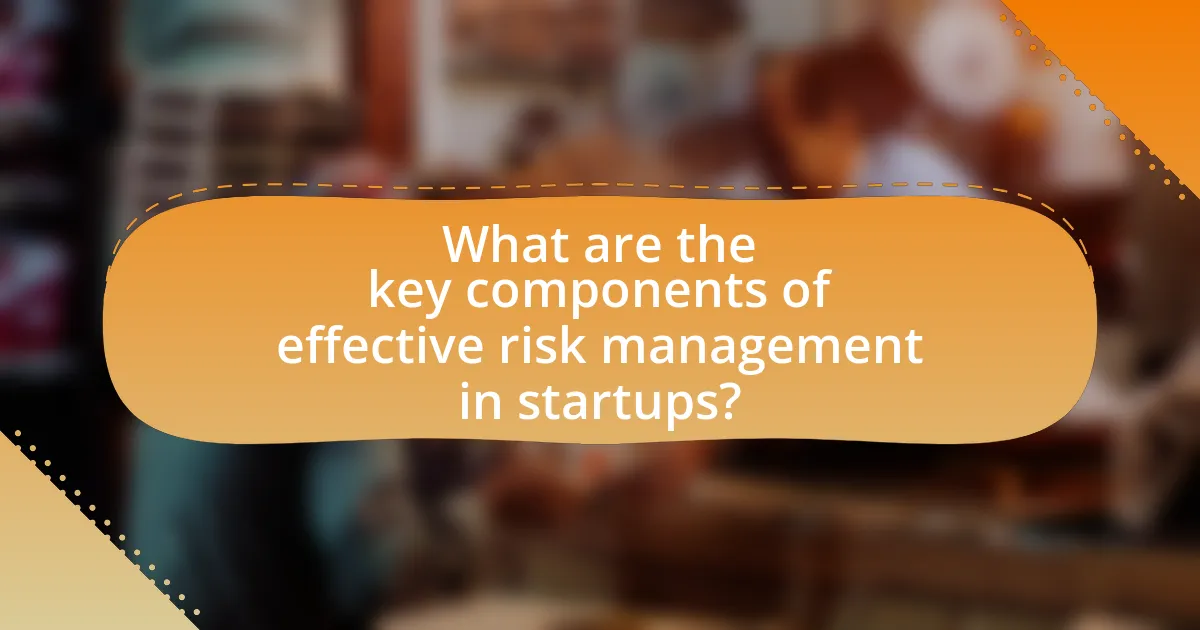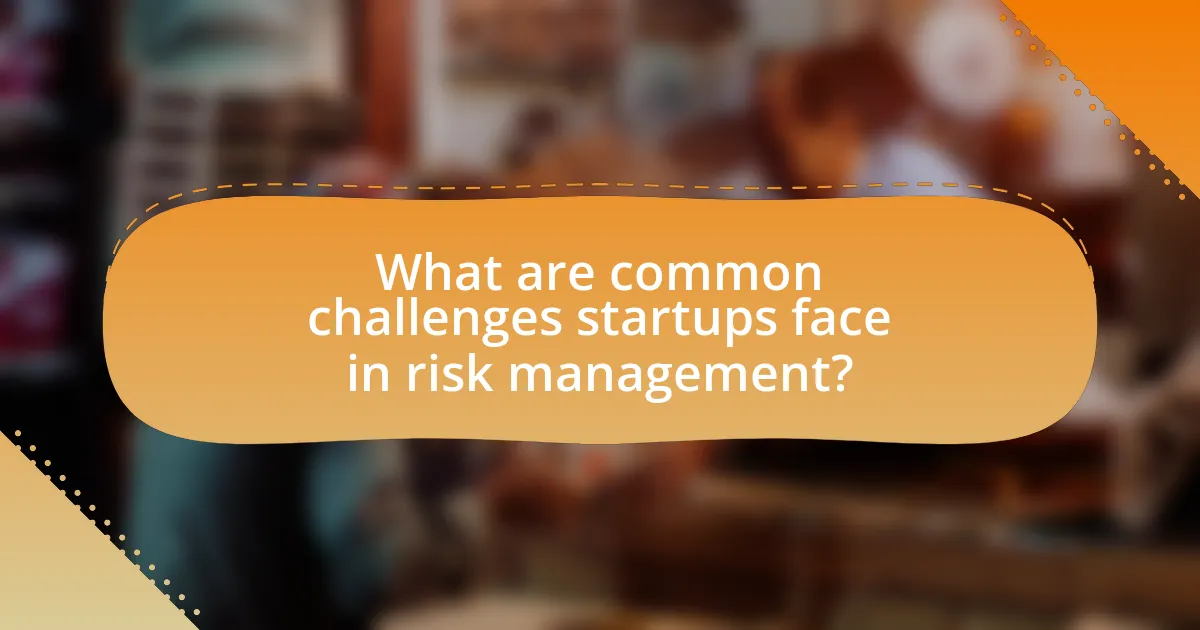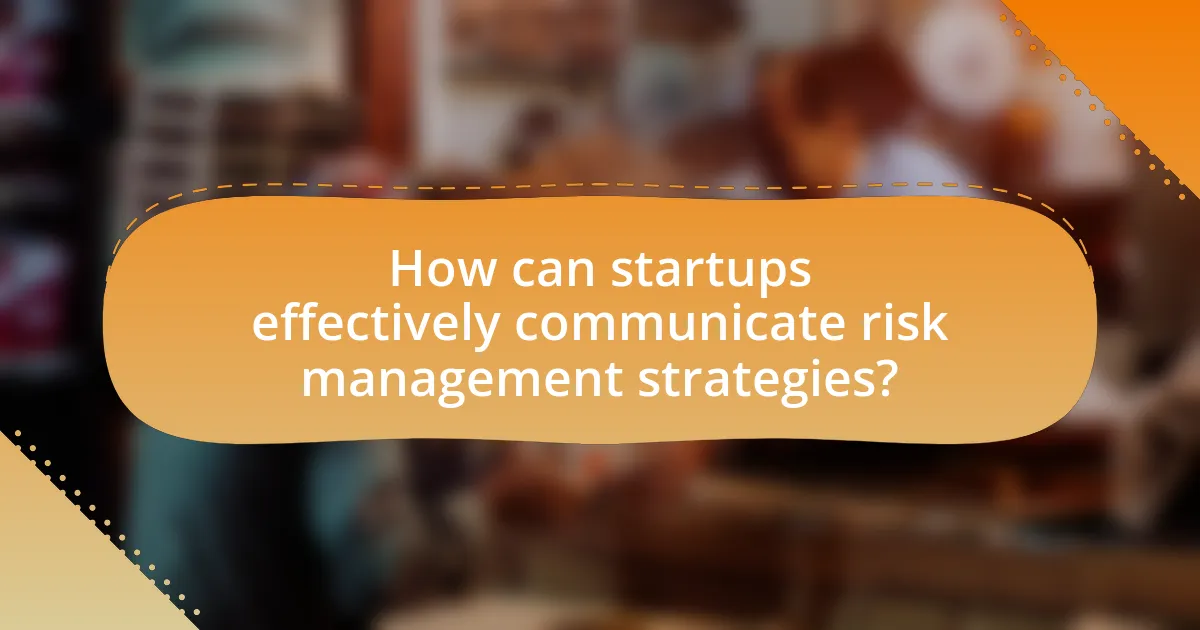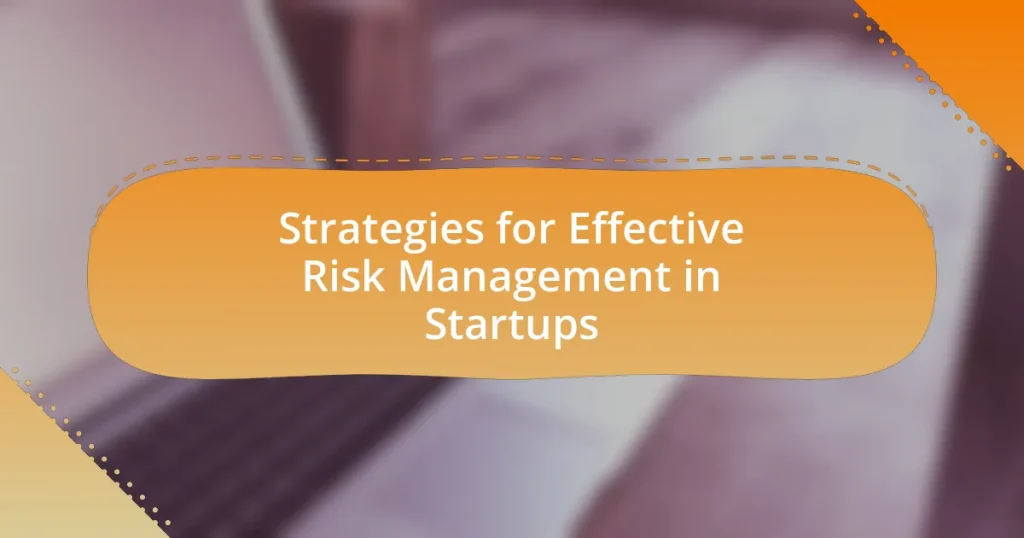The article focuses on strategies for effective risk management in startups, emphasizing key components such as risk identification, assessment, mitigation, and continuous monitoring. It outlines methods for identifying potential risks through market research and stakeholder feedback, and discusses various assessment techniques like SWOT analysis and risk matrices. The article also highlights the importance of prioritizing risks based on their impact, implementing mitigation strategies, and establishing a risk management plan. Additionally, it addresses the role of insurance, continuous monitoring, and the influence of organizational culture on risk management practices, providing practical tips and resources for startups to enhance their risk management skills.

What are the key components of effective risk management in startups?
The key components of effective risk management in startups include risk identification, risk assessment, risk mitigation strategies, and continuous monitoring. Risk identification involves recognizing potential risks that could impact the startup’s operations, such as market fluctuations or regulatory changes. Risk assessment evaluates the likelihood and impact of these risks, allowing startups to prioritize them based on severity. Risk mitigation strategies are then developed to minimize the impact of identified risks, which may include diversifying product offerings or securing insurance. Finally, continuous monitoring ensures that the risk management process remains dynamic, adapting to new challenges as they arise, which is crucial for maintaining operational resilience.
How do startups identify potential risks?
Startups identify potential risks through a combination of market research, SWOT analysis, and stakeholder feedback. Market research allows startups to understand industry trends and customer needs, which helps in identifying external risks such as market volatility. SWOT analysis, which evaluates strengths, weaknesses, opportunities, and threats, provides a structured approach to pinpoint internal and external risks. Additionally, gathering feedback from stakeholders, including employees, customers, and investors, can reveal insights into potential risks that may not be immediately apparent. This multi-faceted approach ensures that startups can proactively address risks before they escalate.
What methods can be used for risk assessment in startups?
Risk assessment in startups can be conducted using methods such as SWOT analysis, scenario analysis, and risk matrices. SWOT analysis identifies strengths, weaknesses, opportunities, and threats, allowing startups to evaluate internal and external factors affecting their business. Scenario analysis involves creating detailed narratives about potential future events, helping startups understand the impact of various risks. Risk matrices provide a visual representation of risks by assessing their likelihood and impact, enabling startups to prioritize risk management efforts. These methods are widely recognized in risk management literature, demonstrating their effectiveness in identifying and mitigating risks in startup environments.
How can startups prioritize risks based on their impact?
Startups can prioritize risks based on their impact by assessing the potential consequences of each risk on their operations, finances, and reputation. This involves categorizing risks into high, medium, and low impact based on their likelihood and severity. For instance, a study by the Project Management Institute indicates that 70% of project failures are due to inadequate risk management, highlighting the importance of prioritization. By focusing on high-impact risks first, startups can allocate resources effectively and implement mitigation strategies that protect their core business objectives.
What strategies can startups implement to mitigate risks?
Startups can implement several strategies to mitigate risks, including thorough market research, financial planning, and agile project management. Conducting comprehensive market research allows startups to understand customer needs and competitive landscapes, reducing the risk of product failure. Financial planning, which includes budgeting and forecasting, helps in managing cash flow and preparing for unexpected expenses, thereby minimizing financial risks. Agile project management enables startups to adapt quickly to changes and feedback, reducing the risk of project delays and ensuring that products meet market demands. These strategies are supported by data indicating that startups with robust market analysis and financial oversight are more likely to succeed, as evidenced by a study from the Harvard Business Review, which found that 70% of startups that conducted thorough market research reported higher growth rates.
How can startups develop a risk management plan?
Startups can develop a risk management plan by identifying potential risks, assessing their impact, and implementing strategies to mitigate them. The process begins with a thorough risk assessment, which involves brainstorming potential risks related to operations, finance, market conditions, and compliance. Once identified, startups should evaluate the likelihood and potential impact of each risk, prioritizing them based on severity.
Next, startups should create a risk response strategy for each prioritized risk, which may include avoidance, reduction, sharing, or acceptance of the risk. Additionally, establishing a monitoring system to track risks and the effectiveness of mitigation strategies is crucial. Regular reviews and updates to the risk management plan ensure it remains relevant as the startup evolves.
Evidence from the Project Management Institute indicates that organizations with formal risk management processes are 2.5 times more likely to meet their project objectives, highlighting the importance of a structured approach to risk management for startups.
What role does insurance play in risk management for startups?
Insurance serves as a critical component of risk management for startups by providing financial protection against unforeseen events that could jeopardize the business’s viability. Startups face various risks, including property damage, liability claims, and business interruptions, which can lead to significant financial losses. By obtaining appropriate insurance coverage, such as general liability, property, and business interruption insurance, startups can mitigate these risks and ensure continuity in operations. According to the National Association of Insurance Commissioners, businesses that carry insurance are better positioned to recover from losses, highlighting the importance of insurance in safeguarding startup investments and fostering long-term stability.
Why is continuous monitoring important in risk management?
Continuous monitoring is crucial in risk management because it enables organizations to identify and respond to risks in real-time, thereby minimizing potential impacts. By consistently tracking risk indicators and changes in the environment, businesses can proactively address emerging threats and adapt their strategies accordingly. Research indicates that organizations employing continuous monitoring are 50% more likely to detect risks early, allowing for timely interventions that can prevent significant losses. This proactive approach not only enhances decision-making but also fosters a culture of risk awareness, ultimately contributing to the long-term sustainability of startups.
How can startups establish a risk monitoring system?
Startups can establish a risk monitoring system by implementing a structured framework that includes risk identification, assessment, and continuous monitoring. This involves regularly evaluating potential risks through tools such as SWOT analysis and risk matrices, which help prioritize risks based on their likelihood and impact. Furthermore, startups should utilize technology solutions like risk management software to automate data collection and reporting, ensuring real-time visibility into risk factors. According to a study by the Project Management Institute, organizations that actively monitor risks are 2.5 times more likely to meet their project goals, highlighting the importance of a proactive approach to risk management.
What indicators should startups track to assess risk levels?
Startups should track financial metrics, market trends, operational performance, and customer feedback to assess risk levels. Financial metrics include cash flow, burn rate, and revenue growth, which indicate financial health and sustainability. Market trends, such as industry growth rates and competitor analysis, help identify external risks. Operational performance indicators, like employee turnover and production efficiency, reveal internal risks. Customer feedback, through surveys and Net Promoter Scores, provides insights into market acceptance and potential product risks. Monitoring these indicators allows startups to proactively manage and mitigate risks effectively.

What are common challenges startups face in risk management?
Startups commonly face challenges in risk management such as limited resources, lack of experience, and difficulty in identifying potential risks. Limited resources often result in insufficient funding for risk assessment tools and strategies, which can hinder effective risk management. Additionally, many startup founders lack experience in navigating complex risk landscapes, leading to inadequate risk identification and mitigation strategies. According to a study by the Global Entrepreneurship Monitor, 70% of startups fail due to mismanagement of risks, highlighting the critical need for effective risk management practices.
How can limited resources affect risk management in startups?
Limited resources significantly constrain risk management in startups by limiting their ability to conduct thorough risk assessments and implement comprehensive mitigation strategies. Startups often face financial, human, and technological constraints, which can lead to inadequate risk identification and prioritization. For instance, a study by the Harvard Business Review indicates that startups with fewer than 10 employees are less likely to have formal risk management processes in place, making them more vulnerable to unforeseen challenges. Consequently, the lack of resources can result in a reactive rather than proactive approach to risk, increasing the likelihood of business failure.
What strategies can startups use to manage risks with limited budgets?
Startups can manage risks with limited budgets by prioritizing risk assessment, leveraging technology, and fostering a culture of adaptability. Conducting a thorough risk assessment allows startups to identify potential threats and allocate resources effectively. Utilizing cost-effective technology solutions, such as cloud services and automation tools, can streamline operations and reduce overhead costs. Additionally, fostering a culture of adaptability enables startups to pivot quickly in response to unforeseen challenges, thereby minimizing potential losses. These strategies are supported by research indicating that proactive risk management can significantly enhance a startup’s resilience and sustainability in competitive markets.
How can startups leverage technology to enhance risk management?
Startups can leverage technology to enhance risk management by utilizing data analytics, artificial intelligence, and cloud-based solutions. Data analytics allows startups to identify potential risks through trend analysis and predictive modeling, enabling proactive decision-making. Artificial intelligence can automate risk assessment processes, improving accuracy and efficiency in identifying vulnerabilities. Cloud-based solutions provide scalable resources for data storage and management, ensuring that startups can access real-time information and collaborate effectively. According to a report by McKinsey, companies that adopt advanced analytics can reduce risk-related costs by up to 30%, demonstrating the tangible benefits of integrating technology into risk management strategies.
What cultural factors influence risk management in startups?
Cultural factors significantly influence risk management in startups by shaping decision-making processes, communication styles, and attitudes toward uncertainty. For instance, a culture that encourages open communication and collaboration fosters a more proactive approach to identifying and mitigating risks. In contrast, a risk-averse culture may lead to avoidance of necessary risks, ultimately stifling innovation. Research indicates that startups in collectivist cultures, where teamwork is emphasized, often exhibit more comprehensive risk assessment practices compared to those in individualistic cultures, where personal achievement may overshadow collective risk considerations. This cultural context directly impacts how startups prioritize and manage risks, influencing their overall success and sustainability.
How can a risk-aware culture be fostered within a startup?
A risk-aware culture can be fostered within a startup by implementing structured risk management practices and promoting open communication about risks. Startups should establish clear policies that define risk assessment processes, encouraging team members to identify and report potential risks without fear of retribution. Research indicates that organizations with a strong risk culture experience 30% fewer incidents related to risk (Institute of Risk Management, 2020). Additionally, regular training sessions on risk awareness and management can enhance employees’ understanding and engagement, further embedding a risk-aware mindset within the organization.
What role does leadership play in shaping risk management practices?
Leadership plays a crucial role in shaping risk management practices by establishing a culture of accountability and proactive decision-making. Effective leaders influence the risk management framework by prioritizing risk awareness, fostering open communication, and encouraging a collaborative approach to identifying and mitigating risks. For instance, a study by the Harvard Business Review highlights that organizations with strong leadership commitment to risk management experience 30% fewer incidents of major risk events. This demonstrates that leadership not only sets the tone for risk management but also directly impacts the effectiveness of risk mitigation strategies within startups.

How can startups effectively communicate risk management strategies?
Startups can effectively communicate risk management strategies by utilizing clear, concise messaging that outlines potential risks, mitigation plans, and the rationale behind these strategies. This approach ensures that all stakeholders, including employees, investors, and partners, understand the risks involved and the measures taken to address them. For instance, a study by the Harvard Business Review highlights that transparent communication fosters trust and engagement, which are critical for startup success. By employing visual aids such as charts and infographics, startups can further enhance understanding and retention of risk management information, making it easier for stakeholders to grasp complex concepts quickly.
What are the best practices for communicating risks to stakeholders?
The best practices for communicating risks to stakeholders include clarity, transparency, and regular updates. Clarity ensures that stakeholders understand the risks in straightforward language, avoiding jargon that may confuse them. Transparency involves sharing both the potential impacts and the likelihood of risks, fostering trust and informed decision-making. Regular updates keep stakeholders informed about any changes in risk status or new risks that may arise, which is crucial for maintaining engagement and preparedness. Research by the Project Management Institute indicates that effective communication can improve project success rates by up to 20%, highlighting the importance of these practices in risk management.
How can startups ensure transparency in their risk management processes?
Startups can ensure transparency in their risk management processes by implementing clear communication protocols and utilizing risk management software. Clear communication protocols involve regularly updating stakeholders on risk assessments and management strategies, which fosters an environment of openness. Utilizing risk management software allows for real-time tracking and reporting of risks, making data accessible to all relevant parties. According to a study by the Project Management Institute, organizations that prioritize transparency in risk management see a 20% increase in project success rates, highlighting the effectiveness of these strategies.
What tools can be used for effective risk communication?
Effective risk communication can be achieved using tools such as risk assessment frameworks, communication plans, and digital platforms. Risk assessment frameworks, like the ISO 31000 standard, provide structured approaches to identify and evaluate risks, ensuring clear communication of potential impacts. Communication plans outline strategies for disseminating information to stakeholders, ensuring that messages are tailored and timely. Digital platforms, including social media and project management tools, facilitate real-time updates and engagement, enhancing transparency and responsiveness in risk communication. These tools collectively support startups in effectively managing and communicating risks, fostering informed decision-making and stakeholder trust.
What practical tips can startups follow for successful risk management?
Startups can achieve successful risk management by implementing a structured risk assessment process. This involves identifying potential risks, analyzing their impact, and prioritizing them based on likelihood and severity. For instance, a study by the Harvard Business Review highlights that startups that conduct regular risk assessments are 30% more likely to survive their first five years compared to those that do not. Additionally, startups should establish a risk management plan that includes mitigation strategies, such as diversifying revenue streams and maintaining a financial buffer. This approach not only prepares startups for unforeseen challenges but also enhances their resilience in a competitive market.
How can startups regularly review and update their risk management strategies?
Startups can regularly review and update their risk management strategies by implementing a structured framework that includes periodic assessments, stakeholder feedback, and data analysis. This approach allows startups to identify emerging risks and evaluate the effectiveness of existing strategies. For instance, conducting quarterly risk assessments can help in recognizing new threats, while soliciting input from team members ensures diverse perspectives are considered. Additionally, leveraging data analytics to track risk incidents and outcomes provides concrete evidence for necessary adjustments. Research indicates that organizations that adopt continuous risk management practices are 30% more likely to mitigate potential threats effectively, highlighting the importance of regular reviews and updates in maintaining robust risk management strategies.
What resources are available for startups to enhance their risk management skills?
Startups can enhance their risk management skills through various resources, including online courses, workshops, and mentorship programs. For instance, platforms like Coursera and Udemy offer courses specifically focused on risk management tailored for entrepreneurs. Additionally, organizations such as the Small Business Administration (SBA) provide workshops and resources that cover risk assessment and mitigation strategies. Mentorship programs, like those offered by SCORE, connect startups with experienced professionals who can provide guidance on effective risk management practices. These resources are validated by their widespread use in the entrepreneurial community, demonstrating their effectiveness in equipping startups with essential risk management skills.



